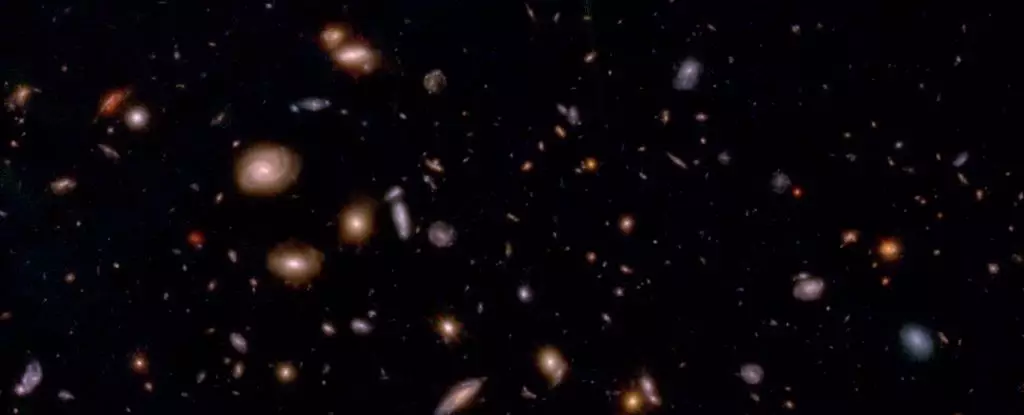Gazing into the expansive night sky, one can’t help but marvel at the sprawling tapestry of galaxies that fill the cosmos. Yet, within this beauty lurks an enigmatic puzzle that challenges our fundamental understanding of the universe. Recent studies reveal a puzzling phenomenon: galaxies seem to exhibit a peculiar preference for a particular direction of rotation. This observation raises critical questions that challenge the conventional wisdom of astrophysics, suggesting that our cosmic model may be fundamentally flawed. Instead of a random assortment of spinning galaxies, the evidence implies a cosmic order we haven’t yet fully understood.
A Paradigm at Odds With Observations
According to current cosmological models, galaxies should spin chaotically, resulting in an even distribution of rotational directions. Interestingly, observations have reported that this is far from the reality: galaxies are predominantly rotating in the same direction. Lior Shamir, our key informant and an astute astronomer at Kansas State University, posits that we face a monumental gap in the existing framework of cosmological understanding. Could the universe itself have been born with a rotation, as posited by theories such as black hole cosmology? This conjecture is as thrilling as it is haunting, presenting us with a universe that not only exists but twists and spins in ways we’re only beginning to comprehend.
Possible Explanations: A Tantalizing Dichotomy
Shamir’s research presents two primary theories to account for the observed asymmetry in galactic rotation. The first predates our very laws of physics, suggesting that the universe emerged from a state of rotation, challenging everything we think we know about cosmic origins. This radical hypothesis would imply that our current models—long considered the cornerstone of cosmology—could be incomplete or even fundamentally erroneous.
On the other hand, there’s the more pedestrian explanation: our own Milky Way’s rotational dynamics could be warping our perception of neighboring galaxies. It suggests the possibility of an observational bias—merely an optical illusion resulting from our position in the cosmos. This isn’t just trivial speculation; rather, it’s bolstered by evidence showing that vast structures like dark matter filaments lend the cosmos a semblance of order, perhaps too quietly influencing surrounding galactic behaviors. Both options carry immense implications for our understanding of universal formation and dynamics, creating a thrilling landscape of inquiry.
Methodology: A Detailed Exploration
To delve deeper into this spinning conundrum, Shamir undertook an extensive analysis of 263 galaxies within the data collected from the James Webb Space Telescope’s Advanced Deep Extragalactic Survey (JADES). This powerful observational tool allows astronomers to probe billions of years into the past, observing galaxies whose light has traversed space for up to ten billion years. In a universe that is isotropic—uniform in every direction—one would anticipate a roughly even distribution of clockwise and counterclockwise spins. However, Shamir’s findings flip this assumption on its head: the galaxies in his sample showed a definitive asymmetry, with 158 spiraling clockwise against 105 counterclockwise.
The ease with which this pattern emerged elicits excitement and intrigue. Shamir remarks, “There is no need for special skills or knowledge to see that the numbers are different.” His assertion underscores the remarkable accessibility of astronomical observation; with the capabilities of the James Webb Space Telescope, anyone can engage with the cosmos, glancing into a deep, mysterious past.
A Shattered Illusion: The Implications of Asymmetry
The implications of Shamir’s findings transcend mere academic curiosity. Should the rotation of our Milky Way prove to significantly influence our observations, it could reshape how we calibrate distance measurements across the universe. The recalibration could revolutionize our understanding of cosmic expansion and the rate at which the universe is growing. If the Milky Way’s influence turns out to be more profound than previously thought, it could lead to a fundamental overhaul in the methodologies used by astronomers and cosmologists alike.
As we stand on the brink of deeper cosmic exploration, the incredible power of the tools at our disposal ignites the imagination. Revolutionary findings lie just ahead, waiting to engulf our understanding of reality. What has been observed is only the beginning; as we dive deeper into the nature of the cosmos, we might uncover more profound truths hidden within the fabric of space-time, leading us to appreciate this magnificent universe even more.

